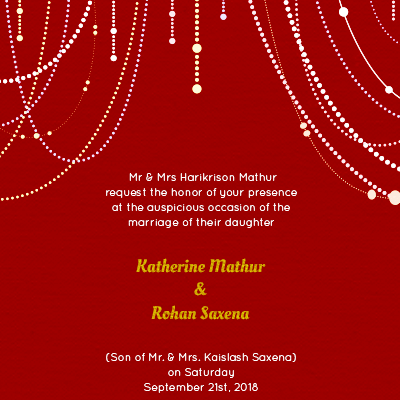
Durgashtami, sometimes written out separately as Durga Ashtami, refers to the culmination of ritual worship and offerings made to the Goddess Durga, or Goddess Maha Gauri as she is sometimes known. This day is also known as Mahashtami. The day of Durgashtami is the eighth day of the Navratri Puja festival, and also happens to be the most important day of the five days of Durga Puja, out of the total of ten days over which this festival is celebrated, because it is during these five days that the actual puja rituals to the Goddess are carried out in temples or “pandals”, the holy stalls set up specifically for such worship. Observing Durgashtami sees a grand celebration of life with all the shades of the color red being splashed across everything from the apparel to the food served on this day, because it is believed to be the favorite color of Goddess Durga. Men and women especially dress in their finest rouge apparel and dance the “garba” around a symbolic lamp or small fire, going around it in rhythmic cadence in praise of Goddess Durga.
Myth and Origins: The Crafty Demon Mahishasura
The story attributed to the reason why Goddess Durga is worshipped on this day begins with the appearance of the demon Mahishasura, said to have had the body of a man but the head of a buffalo, owing to the fact that his father, Mahishi, was a buffalo. He was very powerful and would go to no end to see his evil plans succeed, seeking purely to sow chaos and ignorance everywhere that he went so that what was already there would end up being destroyed under the influence of his powers.
Mahishasura did penance to Lord Brahma for a very long time until the Lord was pleased with his devotion and granted him a boon that no man could kill him. Being an asura already endowed with great power, he used this new gift to continue waging war on the Devas who were led by Lord Indra, their king. After many defeats, the Devas got together and focused all their energies into a form of a goddess, and thus Goddess Durga was born. Imbued with the immense power of the gods, and being a woman and not a man, she set forth to wage war against Mahishasura, the wily shapeshifter, and killed him. Her exploits in this war are said to have been written down in the Devi Mahatmya and is made up of thirteen chapters with a total of seven hundred verses.
Regional Variation in Durgashtami
Although the word “ashta” means eight in Sanskrit, there is some difference in the way that it is associated with as you go from one part of India to another. In some places the notion of eight is thought to be the eight various sub-deities that emerged from the forehead of Goddess Durga, known as the Ashta Shakti, who then went on to kill Mahishasura. The Ashta Shakti are made up of Goddess Brahmani who possesses the characteristic of calmness, like Lord Brahma, Goddess Maheshwari who possesses powers similar to Lord Shiva, Goddess Vaishnavi who possess powers similar to Lord Vishnu, Goddess Koumari who is as pure as the purest virgin, Goddess Aindri, sometimes spelled Oindri, who possess mastery over the senses, Goddess Joggobarahi who possesses powers similar to Varahi, which is one of the avatars of Lord Vishnu, Goddess Narosinghi who is likened to Narasimha, another avatar of Lord Vishnu, and Goddess Chandrika who is a warrior. These goddesses are also worshipped during the course of the 10-day Durga Puja festival in some parts of India.
Traditions and Rituals of Durgashtami
The day of Durgashtami begins with the observance of a fast, the underlying belief of which is if it is taken solemnly and kept for the entire day, until the sun has set, then Goddess Durga will bless the observer of the fast and her family. The focus of Durgashtami, much like Bathukamma [LINK TO BATHUKAMMA BLOG ARTICLE – ABOUT EVENT] which is celebrated in Telangana and Andhra Pradesh during the same time of the year, is the woman or women of the household. The predominant focus is on young girls who are said to be the embodiment of the power that Goddess Durga symbolizes, and one of the rituals associated with Durgashtami is that of washing of the feet of the young girls of the household. In some places, inviting eight young virgins to one’s home to be offered this ritual washing of the feet is yet another way in which the concept of “Ashtami” is interpreted, the belief being that such a household will be blessed for the coming year.
There is no doubt about the popularity of the observance of Durgashtami, certainly as one of the most important days, if not the most important of the days of Durga Puja. This tradition has been passed on for several generations, even making its way to various places around with world in the hearts and minds of the Indian Diaspora. So, what better way to announce the upcoming observance of Durgashtami this year by sending family and friends one of our powerfully designed and most inspired Durgashtami Inytes. Let people know that you are planning a grand celebration that is not to be missed for Durgashtami, and most importantly, that you would like for them to be there celebrating with you. You can attach maps to your Durgashtami Inytes to provide easy-to-use resources to find where exactly you are hosting this celebration, while at the same time being able to track those who RSVP’d in time so that you are able to prepare accordingly for the right number of people to be there. There is no need to hesitate. Simply head on over to Inytes.com and have a gander at our selection of Durgashtami Inytes to get you started.
Durga Puja is one of the biggest and most important festivals in the state of West Bengal, and so at Inytes.com thought we would offer up a recipe of one of the most iconic vegetarian dishes that is associated with Durga Puja specifically, but also West Bengal in general, Aloo Poshto. Considered to be a Bengali Comfort food that pairs excellently with plain rice and a spot of dal curry, for the uninitiated, this dish brings together potatoes (aloo) and poppy seeds (poshto), and before any alarm bells start ringing, there is nothing to worry about, the seeds of the poppy plant have no narcotic effects. In fact, and a rather interesting if somewhat disturbing fact, is that poppy seeds are a waste by-product of poppy cultivation, for the numerous legitimate reasons why this plant is cultivated.
The disturbing fact part has to do with how poppy seeds gained immense popularity as part of the cuisine of West Bengal, and also Odisha and a few other neighboring states that were subjected to intense poppy growing by the occupying British, mostly because farmers had been turned away from growing crops they would otherwise have kept a little of to feed themselves. The reason for the British push to grow poppies on such an immense scale would be much more evident as time went on and the Opium Wars came to fought. The inclusion of poppy seeds in the diet was a desperate attempt to make ends meet, because let us accept the reality of what happened by acknowledging the fact that these farmers never derived anywhere near the level of income from growing poppy that the agents and dealers at the end of the supply chain did. So when faced with mounds of poppy seeds being discarded, the farmer saw these seeds as a ready and welcome supplement to their already meagre diets. But historical downers aside, the delectable Aloo Poshto is a definite must have in the repertoire of any kitchen maestro, so here is the recipe for you to try and enjoy. You will notice however, the very few ingredients that go into making this dish…
Ingredients for Aloo Poshto
- 2 Large Potatoes, make sure that these are a waxier potato variety than the starchy kind of potato that tends to disintegrate very easily when it cooks completely
- 2-3 Tablespoons of Mustard Oil, to begin frying the potato
- 3 Large Green Chilies
- 3 Tablespoons of dried White Poppy Seeds, which is also known as “khus khus” in Hindi
- ½ Teaspoon of Nigella Seeds, which is also known as “kalonji” in Hindi
- ¾ to 1 Cup of water, which will be used in small amount to prepare the paste of poppy seeds, as well as to cook the potatoes, since this dish is usually served dry without any gravy. Feel free to increase the amount of water according to your preference for the consistency of the finished Aloo Poshto, or as necessary inclusive of soaking and grinding the White Poppy Seeds into a paste.
- ¼ Teaspoon of Sugar, which will help bring out the more subtle flavours, like the heat from the Mustard Oil and the Green Chilies, but is considered to be an optional addition to this dish
- ¼ Teaspoon of Turmeric Powder, another optional ingredient because there are recipes out there which omit this ingredient religiously. However, the addition of Turmeric lends itself to giving the potatoes a lovely golden color, which is rather appealing visually
- Salt to Taste
Steps to Make the Poppy Seed Paste
- Soak the White Poppy Seeds in a ¼ cup of Water for at least 4-6 hours. If you can, the ideal amount of time to soak them would be overnight, but in a pinch you may be able to get away with a couple of hours if you warm the water you will be soaking the White Poppy Seeds in.
- Drain the soaked White Poppy Seeds of the water they have been soaking in.
- Chop up one Green Chili and put it in a blender or food processor along with the drained White Poppy Seeds, grinding these ingredients into a mostly fine paste. You may find that you have to add about a tablespoon of water to achieve a paste-like consistency, especially if the seeds move away from the spinning blades of your blender or food processor and stick to the sides, almost as if refusing to be ground down.
- Once you have achieved the perfect consistency of the White Poppy Seed paste, keep it aside, ready to be added to the potatoes.
Steps to Make the Aloo Poshto
- Peel and chop the potatoes into large chunks, roughly half-inch cubes. Wash them to get rid of some of the starch that accumulates on the cut faces of these potato cubes and drain them of any excess water.
- In a frying pan which you can cover with a lid, heat up the Mustard Oil on a medium flame. Please Note: If you see the Mustard Oil smoking, reduce the flame to prevent the Mustard Oil from burning.
- Once the Mustard Oil has heated up sufficiently, add the Nigella Seeds and swish them around in the hot Mustard Oil for a few seconds.
- Throw in the chopped potatoes and move them around in the Mustard Oil so that they are coated in the oil and Nigella Seeds.
- Stir the potatoes occasionally until you see that they are about half done, usually when the edges of the potato pieces become a little translucent. Please Note: There is no need to try and get the potatoes to crisp up and form any sort of light golden crust. They only need to show signs of beginning to cook on the lowered heat with which you are cooking.
- When the potato cubes are half cooked, sprinkle the Turmeric Powder and mix it in among the potato pieces so that they are all coated, or rather, tinged golden because of it.
- Chop the remaining two green chilies, or simply slit them along their length and add them to the potatoes. Stir them in among the potato pieces for a few seconds.
- Add the Poppy Seed Paste to the pan and mix it in to coat the potato pieces. Use the remaining water to rinse the remaining paste out of your blender or food processor, roughly ¾ cup or little less depending on how much you used to grind the poppy seeds, and pour this into the pan. Mix the contents of the pan once again.
- Sprinkle some Salt and the ¼ teaspoon of Sugar if you plan on using it and mix everything together before placing the lid on the pan.
- Keep an eye on the pan and remove from the heat once you see that the potato pieces have cooked without smashing too easily when you press them against the side or bottom of the pan. Generally, once the water has evaporated, the potato pieces will have cooked to the perfect consistency, leaving a dish of cubed potato pieces coated with the Poppy Seed paste. However, if you plan to have a little more gravy, then feel free to add more water, only checking to see that the potatoes are cooked and not overcooked to near mashing consistency, because the evaporation of the water will not serve as a visual cue in this case.
- Serve the Aloo Poshto with plain rice and some dal, or another curry of your choosing, and enjoy this simple but delicious and nutritious meal.
Additional Information
- If you noticed from the recipe, this dish is very unlike more traditional curries or even dry or thick-gravy dishes because it does not use onions, tomatoes, garlic, ginger, or any other ingredient generally associated with forming the base of most Indian dishes. However, you will be pleasantly surprised at how much flavour there is in Poppy Seed Paste and the Mustard Oil which come together to create a wholly astounding flavour profile.
So, there you have it, an unassuming but very tasty Aloo Poshto that you simply have to try out. And now that you have gone through the recipe, in what we can only assume is part of your preparation for Durgashtami, we would like to draw your attention to the Durgashtami Inytes that we have on our website, Inytes.com. Dazzle your friends and family with our artistically appealing Durgashtami Inytes, and then amaze them even more by hosting the perfect celebration of this holy and auspicious festival to share the love and blessings in each other’s company. On that note, here’s wishing you a Joyously Festive Durgashtami, from all of us here at Inytes.com.





